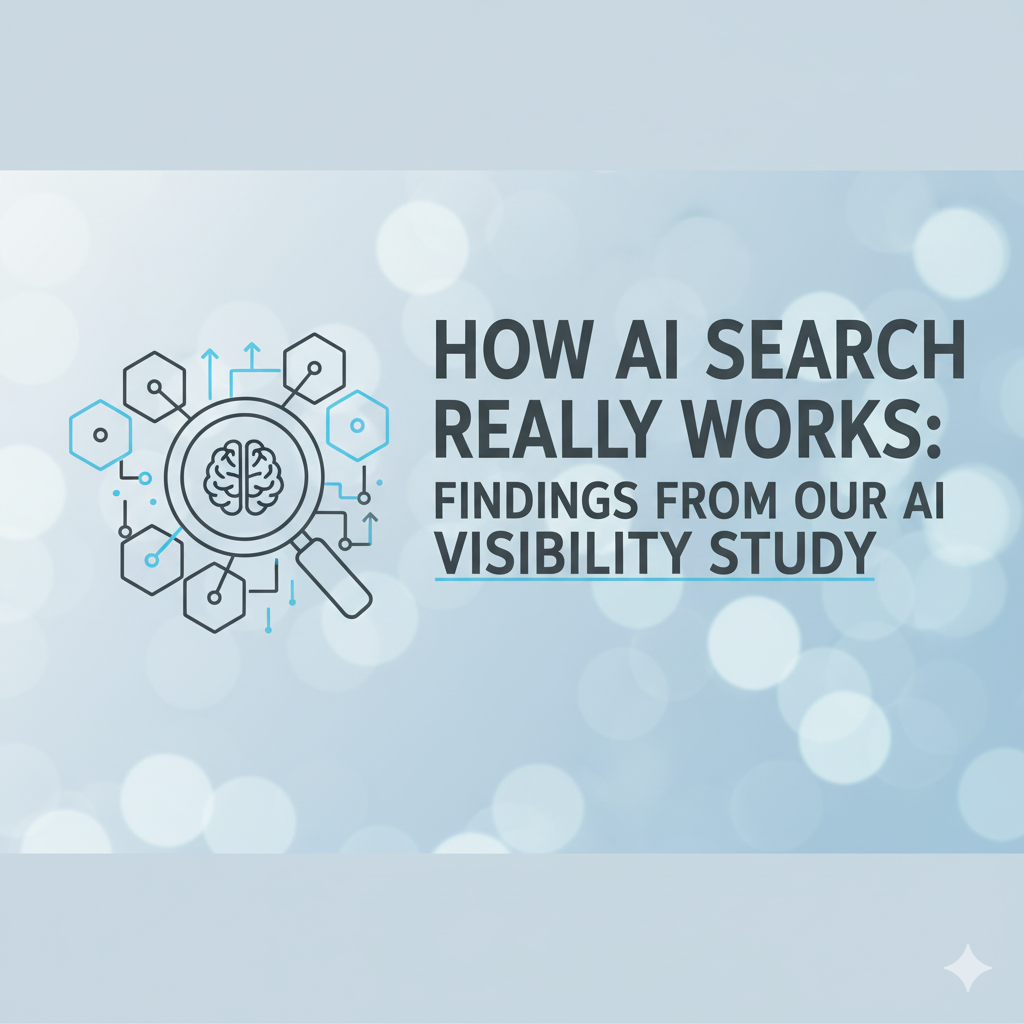
27 August 2025
How AI Search Really Works: Findings from Our AI Visibility Study
Introduction
Artificial Intelligence (AI) is rapidly reshaping how we interact with search technology. From personalized recommendations to predictive text, AI search technology is no longer just a futuristic concept—it is an everyday reality. But how well do businesses truly understand AI-driven search engines, and what does this mean for their online visibility?
To answer these questions, we conducted an AI Visibility Study, analyzing how AI impacts search results, rankings, and overall discoverability. The study provides critical insights into how AI algorithms interpret content, prioritize relevance, and ultimately affect consumer behavior online.
In this blog, we share our key findings, their implications for businesses and consumers, and what this means for the future of search engine optimization (SEO).
Key Findings from the AI Visibility Study
1. Relevance and Context Matter More Than Keywords
Traditional search engines relied heavily on exact keyword matches. However, our study shows that AI search technology prioritizes context over raw keywords. AI-powered search engines analyze semantic meaning, user intent, and contextual relationships between words.
- Example: Instead of ranking for the keyword “best laptops,” AI algorithms consider the broader context such as user reviews, expert comparisons, and real-time pricing trends.
2. Content Freshness Has a Higher Weight
We observed that AI-driven search gives preference to fresh, updated, and frequently optimized content. Static web pages that haven’t been revised in months or years tend to lose visibility over time.
- This means businesses need to regularly update blogs, product pages, and FAQs to remain competitive.
3. User Engagement Signals Are Crucial
Click-through rates, dwell time, and bounce rates are now strong ranking factors in AI-powered search. AI tracks user behavior to determine whether a page genuinely satisfies search intent.
- Example: Articles with interactive elements (infographics, videos, polls) tended to rank higher than plain text articles, even when both were relevant.
4. Authority and Trust Signals Drive Ranking
Our visibility study found that AI algorithms give greater weight to domain authority, backlinks from credible sources, and brand reputation. Content from trusted publishers and industry leaders consistently outperformed newer or less credible websites.
5. Personalization Is Transforming Results
AI search is increasingly personalized based on user history, location, and device type. Two people searching for the same keyword may receive different results depending on their browsing behavior and preferences.
- For example, someone searching “restaurants near me” in Delhi will see vastly different results than someone in New York, even if they use the same phrasing.
Implications of the Findings
For Businesses
- SEO strategies must evolve: Focusing solely on keywords is no longer effective. Businesses must create content that addresses user intent and context.
- Content refresh cycles are critical: Regularly updating blogs, case studies, and landing pages is essential to maintaining visibility.
- Authority building is key: Investing in digital PR, backlink acquisition, and thought leadership will directly impact rankings.
- User experience drives growth: Interactive, engaging, and mobile-friendly websites will benefit most from AI-driven search.
For Consumers
- More relevant results: AI ensures that users see content that closely matches their intent, reducing irrelevant or spammy results.
- Dynamic personalization: Consumers benefit from customized recommendations and search results tailored to their preferences.
- Better trust signals: Results are increasingly filtered to highlight authoritative sources, making it easier to access reliable information.
Conclusion
The AI Visibility Study confirms that the future of search is deeply intertwined with artificial intelligence. AI search technology is shifting the focus from static keywords to dynamic user intent, engagement, and authority. For businesses, this means rethinking traditional search engine optimization practices and embracing strategies that emphasize context, freshness, and trustworthiness. For consumers, it translates into more accurate, personalized, and reliable search experiences.
As AI continues to evolve, the gap between traditional SEO and AI-driven search will only widen. Businesses that adapt early—by creating relevant, engaging, and authoritative content—will be the ones that thrive in this new digital landscape.
Next Steps:
- Audit your website for freshness and context-driven content.
- Invest in engagement tools like videos, interactive media, and surveys.
- Build credibility through backlinks, thought leadership, and brand reputation.
By aligning strategies with the findings of our AI Visibility Study, businesses can not only maintain but also grow their online presence in the era of AI-powered search.
 Digital SEO Bull
Digital SEO Bull